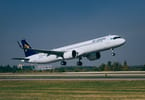Dallas — Gary Kelly has a standing offer: a steak dinner to anyone who can prove that Southwest Airlines (LUV) does not carry more domestic business travelers than any U.S. carrier.
It’s a sucker’s bet, of course.
Southwest Airlines’ CEO knows he’ll never have to pay up. There’s no way to prove him wrong because airlines don’t know the purposes of many customers’ trips.
Kelly maintains that internal research shows Southwest is already No. 1 in domestic business travel, and he is steering Southwest to capture even more of the business-travel market in 2009. To accomplish that, he’s doing some heavy tinkering with a business model that has kept the airline profitable for an unprecedented 35 consecutive years.
It’s risky, but in a deepening recession, it may be less risky than standing pat. Southwest will shrink overall next year — the first time it’s ever done that — but the nation’s largest low-fare airline will also expand aggressively in some big business markets because that’s where the most profitable travelers are.
FIND MORE STORIES IN: Texas | New York City | Nashville | Los Angeles | Denver | Southwest Airlines | Kelly | Twin Cities | New York LaGuardia Airport | Minneapolis-St | ATA Airlines | Chicago Midway | Dave Ridley
Two new airports are already on the agenda: Minneapolis-St. Paul in March and, at a still-to-be-determined date, New York’s LaGuardia, which will host Southwest’s first flights at any of the three major New York metro airports. Kelly this month said he wants to launch service in a third big market in 2009. Southwest is also set to increase service on heavy business-travel routes to and from airports such as Chicago Midway, Denver, Los Angeles and Nashville.
Meanwhile, other important changes have come or are in the works. Airport gates have been updated with business-traveler-friendly features such as laptop workstations. It still doesn’t assign seats, but Southwest’s formerly chaotic boarding process has been changed to move its best customers and those willing to pay a higher fare to the front of the line so they get first choice of seats.
Less noticeable, but just as important, Southwest last year began using a sophisticated computer system that enables it to offer up to 15 different fares. The old system, in use for 20 years, offered as few as three fares on many routes. The new pricing system enables Southwest to boost its total revenue without resorting to huge across-the-board price increases. Similarly, a new flight-scheduling system that Southwest began using earlier this year is allowing it to better match capacity to demand. It gradually is reducing flight frequencies on lower-demand routes and adding flights on more-lucrative, heavy-demand business-travel routes.
Those new pricing and schedule-planning systems will be seriously tested in 2009 and beyond as Southwest increasingly challenges conventional competitors in new and larger markets.
Getting into Minneapolis-St. Paul
Southwest is entering both the Twin Cities and New York City markets in a small way: just eight flights a day from Minneapolis-St. Paul and seven a day from LaGuardia. The Minneapolis-St. Paul flights will go only to Chicago’s Midway airport. Southwest has a major operation at Midway, with 214 flights a day, allowing Minneapolis-St. Paul travelers to catch connecting flights to 47 of Southwest’s 61 other destinations with just one stop in Chicago.
Over time, Southwest is likely to add non-stop flights from Minneapolis-St. Paul to other major markets. But its history shows that many business travelers often will gladly accept one-stop service to save hundreds of dollars a trip.
“We’ve always appealed most to people who pay for it out of their own pocket, whether it be entrepreneurs, or small-business owners, or professionals who recognize that what they spend on travel isn’t coming out of some big corporation’s travel budget but out of their own pocket,” says Dave Ridley, Southwest’s senior vice president.
“But that doesn’t mean we don’t appeal to those who don’t pay for it out of their own pocket,” he adds.
To entice more business travelers, Ridley says Southwest has been making a concerted effort to re-establish its brand image in markets beyond its home turf in Texas.
A key element of that effort is a heavy run of humorous TV commercials that drive home the message that Southwest doesn’t charge extra fees for services such as checking bags, making reservations over the phone or changing flights at the last minute. “We are trying to convince business travelers that our service offerings really do meet their needs,” Ridley says.
Tiptoeing into New York
Southwest’s entry into LaGuardia also will start small. It is buying defunct ATA Airlines’ 14 time-specific landing and takeoff slots at LaGuardia. That’s enough for only seven daily flights, but that puts Southwest flights within a short cab ride of the USA’s largest concentration of financial, advertising, communications and legal-services firms.
One challenge serving LaGuardia, Kelly says, will be pricing Southwest’s flights high enough to cover the high costs of operating there but low enough to maintain its appeal as a low-fare carrier. Another will be communicating what Southwest offers to sophisticated New York-area travelers who have little understanding of Southwest’s quirky ways.
“Southwest is still a niche carrier in some ways,” Kelly says. “We won’t get you from New York City to Topeka, Kan., or to Frankfurt, Germany. So our message there, as it is most everywhere else, will be localized. Talking to New Yorkers about the Southwest Airlines product at LaGuardia is going to be very different from talking to Chicagoans about our 225 or so daily departures at Midway.”
Southwest officials admit they’ll never win over business travelers who value first-class seating and other high-end services many large airlines offer.
Eric Burger, an executive consultant from Amherst, N.H., is one such traveler. He flies Southwest only a handful of times each year because he usually can buy a comparable coach fare on his preferred carrier, United, and then use his frequent-flier status to score an upgrade to first class.
Southwest’s boarding procedure changes “make the experience more predictable for the business traveler,” and the carrier a more viable option, he says. Still, it remains his last choice.
Southwest’s push into more and larger business-travel markets — while reducing service in some smaller markets — amplifies a trend that goes back to the early 1990s. Most of Southwest’s new markets in the last decade have been big ones.
Since 2004 it has entered the Philadelphia, Denver, Pittsburgh and San Francisco markets, and launched service at Washington’s Dulles International. Denver has become in just three years the fastest-growing market in Southwest’s history. That’s despite the presence of two hubs operated by giant United (UAUA) and struggling discounter Frontier.
Southwest’s growth in big, business-travel-oriented markets also has benefited from — or, arguably, caused — other carriers’ decisionsto reduce service on domestic routes. When oil prices began soaring this year, other major airlines reduced flying. The result has been a drop in total U.S. airline capacity of more than 10% this quarter — a reduction that Kelly says creates abundant opportunities for Southwest.
વૃદ્ધિની તકો
Southwest itself has been affected by, first, high fuel prices earlier this year, and, now, slumping travel demand. In the third quarter it posted its first quarterly loss — $120 million — since 1991 because the fall in oil prices led to accounting adjustments related to the reducedvalue of its hedges on future oil consumption. It also has begun shrinking. In January Southwest’s capacity will be down about 5% from January 2008, but a 2009 profit is expected.
“Our competitors all over the country are pulling 15% to 20% of their seats out of our markets in the fourth quarter,” Kelly says. “That … gives us a chance to grow significantly” in the USA.
Bill Swelbar, a research engineer at the Massachusetts Institute of Technology’s International Center for Air Transportation and a widely followed blogger on airline matters, expects Southwest to enter over the next several years the few remaining big cities it doesn’t serve. Boston, Atlanta and perhaps Charlotte head that list.
That will complicate Southwest’s operations and increase its costs, he adds. “But my guess is they’ve done the calculus and have concluded that the revenue upside is going to be more than enough to offset” those higher costs.
આ લેખમાંથી શું દૂર કરવું:
- “We’ve always appealed most to people who pay for it out of their own pocket, whether it be entrepreneurs, or small-business owners, or professionals who recognize that what they spend on travel isn’t coming out of some big corporation’s travel budget but out of their own pocket,”.
- It still doesn’t assign seats, but Southwest’s formerly chaotic boarding process has been changed to move its best customers and those willing to pay a higher fare to the front of the line so they get first choice of seats.
- 1 in domestic business travel, and he is steering Southwest to capture even more of the business-travel market in 2009.






















